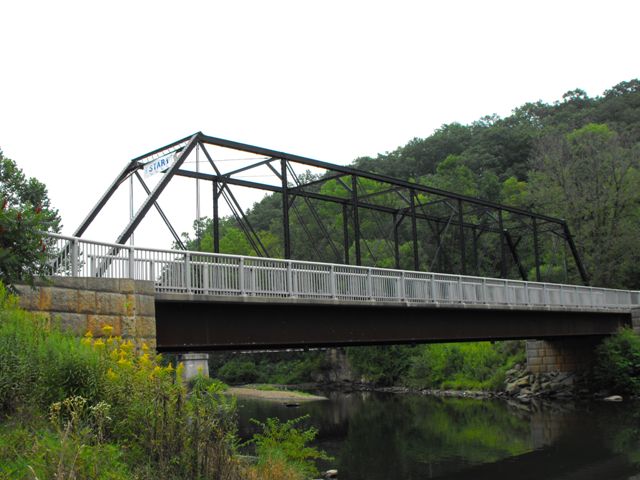We Recommend:
Bach Steel - Experts at historic truss bridge restoration.
BridgeHunter.com Phase 1 is released to the public! - Visit Now
Jersey Bridge

Primary Photographer(s): Nathan Holth
Bridge Documented: August 1, 2010
Rural: Venango County, Pennsylvania: United States
1882 By Builder/Contractor: Morse Bridge Company of Youngstown, Ohio
1999
134.8 Feet (41.1 Meters)
140.0 Feet (42.7 Meters)
11.5 Feet (3.51 Meters)
1 Main Span(s)
60101100101480

View Information About HSR Ratings
Bridge Documentation
View Archived National Bridge Inventory Report - Has Additional Details and Evaluation
View a PDF Archive of Comments From Daniel Alward
The truss structure seen here is a rare example of a through truss built by the Morse Bridge Company of Youngstown, Ohio, which later became the Youngstown Bridge Company. The Morse Bridge Company is one of the most fascinating bridge companies ever to have existed because unlike other bridge companies, this company did not stick to a small variety of standard bridge designs, in terms of built-up beam designs and aesthetic treatment. Instead, the company designed bridges with a wide variety of exact member designs. The bridges also usually feature a wide variety of varied aesthetic treatment. Morse Bridge Company aesthetics were usually not superficial, but instead were functional decorations with a decorative portal bracing of any number of styles being the most common treatment. The Jersey Bridge actually stands out as one of the company's more unadorned bridges, although it is still beautiful by way of its traditionally composed trusses with built-up beams containing v-lacing and the lattice portal bracing.
This bridge is noteworthy from a preservation standpoint. While not a true example of preservation, it does represent one of the broad spectrum of alternatives available to complete demolition and replacement of a historic bridge. When a historic bridge cannot be preserved in its entirety and needs to be replaced, this is a good example of a compromise that retains a significant portion of the original bridge materials. This solution seen at this bridge is a good example of the spirit and intent of the Section 106 process being followed when it is determined that bridge replacement is the only acceptable alternative.
This bridge demonstrates a scenario where the truss webs and the bracing is placed on top of a replacement bridge, and although the roadway width remains the same, the new bridge is wider because a sidewalk was added. Other approaches to installing a new loadbearing bridge include adding a steel arch within the truss lines, placing stringers below the existing bridge's floorbeams, or first removing the floorbeams and deck system and placing stringers within the footprint that was occupied by the floorbeams, which is similar to this bridge, but in some cases part of the floorbeams are retained to give a greater sense of the original bridge's function. The original bridge width would be maintained in this solution. The solution seen on this bridge obstructs the view of the trusses somewhat, however it does not require alteration of the floorbeams or other parts of the truss, so original materials remain on the bridge.
This bridge sits at a historic location, near the site where Edwin Drake was the first person credited to use a drill to find oil, an effort made successful by his idea of driving pipe into the ground to stabilize and contain the hole being drilled. The location is often called the birthplace of oil.
This bridge is tagged with the following special condition(s): Trusses Converted To Decorative
![]()
Photo Galleries and Videos: Jersey Bridge
Bridge Photo-Documentation
Original / Full Size PhotosA collection of overview and detail photos. This gallery offers photos in the highest available resolution and file size in a touch-friendly popup viewer.
Alternatively, Browse Without Using Viewer
![]()
Bridge Photo-Documentation
Mobile Optimized PhotosA collection of overview and detail photos. This gallery features data-friendly, fast-loading photos in a touch-friendly popup viewer.
Alternatively, Browse Without Using Viewer
![]()
Maps and Links: Jersey Bridge
Coordinates (Latitude, Longitude):
Search For Additional Bridge Listings:
Bridgehunter.com: View listed bridges within 0.5 miles (0.8 kilometers) of this bridge.
Bridgehunter.com: View listed bridges within 10 miles (16 kilometers) of this bridge.
Additional Maps:
Google Streetview (If Available)
GeoHack (Additional Links and Coordinates)
Apple Maps (Via DuckDuckGo Search)
Apple Maps (Apple devices only)
Android: Open Location In Your Map or GPS App
Flickr Gallery (Find Nearby Photos)
Wikimedia Commons (Find Nearby Photos)
Directions Via Sygic For Android
Directions Via Sygic For iOS and Android Dolphin Browser
USGS National Map (United States Only)
Historical USGS Topo Maps (United States Only)
Historic Aerials (United States Only)
CalTopo Maps (United States Only)

